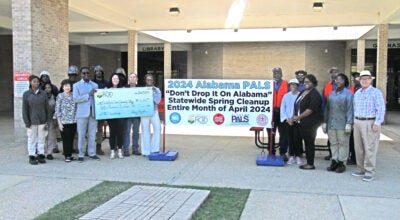Flu hits schools
Published 12:50 am Wednesday, March 4, 2009
In the coming weeks, influenza season draws to a close. The flu hit area schools with varying force between early October and March, according to school officials.
John T. Morgan Academy headmaster Randy Skipper said he sent five or six students home Friday because their temperatures measured more than 100 degrees. On average, 65 students missed school each day during flu season. School officials said about 35 of those were due to the flu or other flu-like viruses.
“It has affected us,” Skipper said.
Maintenance crews mopped the floor with disinfectant Saturday, and Skipper said teachers diligently sprayed desks with disinfectant, too. The faculty also encouraged students to wash their hands as often as possible.
“We’re making an effort, but it’s a battle,” Skipper said.
Meadowview Christian School battled the flu bug, too. English teacher Rexene Redd said the school saw its share of flu-related absences this year, and her three children missed multiple days of school due to the flu.
“I know we’ve had a lot of students absent,” she said.
Redd said teachers are more cautious than usual during flu season.
“As teachers, we’re very conscientious when people are sick to disinfect.”
Selma City Schools remained unscathed for the most part. Public relations and attendance supervisor Crystal Boykin said this flu season was mild compared to years past.
“To my knowledge, we haven’t really had a problem this year,” Boykin said.
Dallas County Schools saw similar numbers this flu season, according to administrative assistant Don Willingham. He said the system’s absences during January and February, the peak of flu season, resembled 2008’s numbers.
“We haven’t had too much rise in absenteeism,” Willingham said.
He said the system could see cases in the week to come though, with the recent fluctuation in weather and the threat of spreading germs. He said administrators and teachers at schools around Dallas County system encourage students to wash their hands and only touch their own things to limit germ spreading.
“The spreading of germs is the key,” Willingham said.
Dr. Bruce Taylor, a local physician, said he has seen about seven or eight cases of the flu at his office on U.S. Highway 80 West. Taylor said most patients who visit Taylor Internal Medicine received the flu vaccine when it arrived in late September.
There are two types of vaccines: the flu shot, which is given with a needle in the arm and is approved for use in people older than six months, and the nasal-spray, which is approved for use in people age 2 to 49 who are not pregnant.
The Centers for Disease Control and Prevention recommends the following people should be vaccinated each year: children between six months and 19 years old, pregnant women, people 50 and older, people with chronic illnesses and people who live in nursing homes or other long-term care facilities.
Taylor said combining the flu vaccine with a healthy lifestyle is the best way to prevent the virus. However, he said since most people are in close contact with other people in winter, such as students in a classroom, some cases of the flu are inevitable. Since the flu is a viral illness, it is spread through close contact.
“You’re in close proximity to so many other folks,” Taylor said. “You just have to be more aware.”
Each year in the United States, on average 5 to 20 percent of the population contracts the flu virus, and more than 200,000 people are hospitalized from flu complications, according to the CDC.




